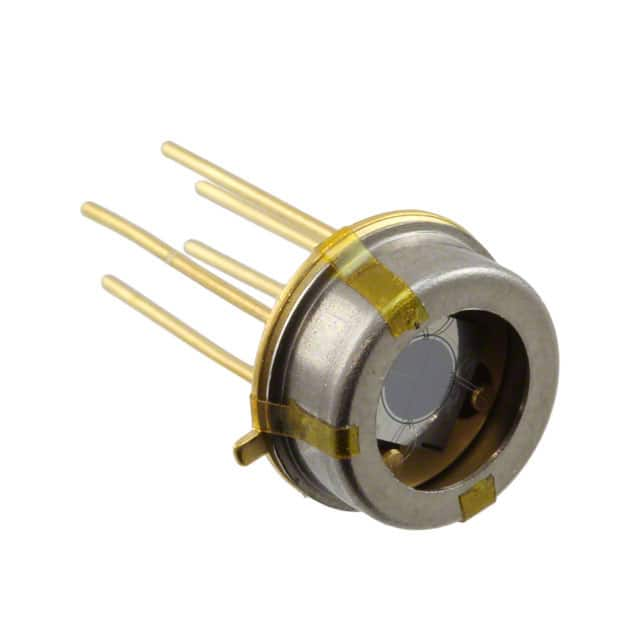Lihat spesifikasi untuk detail produk.

SXUVPS4 Product Overview
Introduction
The SXUVPS4 is a versatile and high-performance photodiode designed for use in various applications. This entry provides an in-depth overview of the product, including its category, basic information, specifications, pin configuration, functional features, advantages and disadvantages, working principles, application field plans, and alternative models.
Basic Information Overview
- Category: Photodiode
- Use: Detection of ultraviolet, visible, and near-infrared radiation
- Characteristics: High sensitivity, low dark current, wide spectral range
- Package: TO-5 metal can package
- Essence: Silicon photodiode with UV-enhanced response
- Packaging/Quantity: Available in single units or bulk packaging options
Specifications
- Active Area: 5.76 mm²
- Spectral Range: 1 nm to 400 nm (UV), 400 nm to 1100 nm (visible and near-infrared)
- Responsivity: 0.08 A/W at 200 nm, 0.45 A/W at 850 nm
- Dark Current: 100 pA at 25°C
- Reverse Breakdown Voltage: 10 V
- Capacitance: 15 pF
Detailed Pin Configuration
The SXUVPS4 photodiode features a standard 3-pin configuration: 1. Anode (A) 2. Cathode (K) 3. Case (C)
Functional Features
- High sensitivity across UV, visible, and near-infrared spectra
- Low dark current for improved signal-to-noise ratio
- Hermetically sealed TO-5 package for robustness and reliability
- Wide operating temperature range (-40°C to 125°C)
- Low capacitance for fast response times
Advantages and Disadvantages
Advantages
- Versatile spectral response for multi-wavelength applications
- Low dark current enhances signal detection in low-light conditions
- Robust packaging ensures durability in harsh environments
- Wide operating temperature range enables diverse usage scenarios
Disadvantages
- Limited to specific spectral ranges, may not be suitable for broad-spectrum applications
- Higher capacitance compared to some specialized photodiodes
- Requires careful handling due to the sensitive nature of the semiconductor material
Working Principles
The SXUVPS4 operates based on the principle of internal photoelectric effect. When exposed to incident radiation, the photodiode generates electron-hole pairs, resulting in a photocurrent proportional to the incident light intensity. The reverse bias voltage applied across the diode controls the flow of this photocurrent, allowing for precise detection and measurement of light.
Detailed Application Field Plans
The SXUVPS4 finds extensive use in various fields, including: - UV spectroscopy and radiometry - Flame and plasma detection - Laser power monitoring - Medical diagnostics and fluorescence measurements - Environmental monitoring and UV dosimetry
Detailed and Complete Alternative Models
For users seeking alternative photodiode options, the following models offer similar functionality: 1. SXUV100: Extended UV response with lower dark current 2. SXUV20HS1: Higher speed and lower capacitance for pulsed laser applications 3. SXUV300C: Enhanced visible and near-infrared response with reduced UV sensitivity
In conclusion, the SXUVPS4 photodiode stands as a reliable and efficient solution for diverse light detection needs, offering high sensitivity, robust packaging, and broad spectral coverage.
Word Count: 536
Sebutkan 10 pertanyaan dan jawaban umum terkait penerapan SXUVPS4 dalam solusi teknis
What is SXUVPS4?
- SXUVPS4 is a silicon photodiode with a UV-enhanced response and a large active area, making it suitable for detecting UV light in technical solutions.
What is the spectral range of SXUVPS4?
- The spectral range of SXUVPS4 is typically from 10 nm to 400 nm, with peak sensitivity in the UV region.
How can SXUVPS4 be used in technical solutions?
- SXUVPS4 can be used for UV detection in applications such as spectroscopy, environmental monitoring, flame detection, and UV curing processes.
What are the key features of SXUVPS4?
- SXUVPS4 features high responsivity, low dark current, and a large active area, making it ideal for precise UV detection in various technical solutions.
Is SXUVPS4 suitable for low-light UV detection?
- Yes, SXUVPS4's low dark current makes it well-suited for low-light UV detection applications where sensitivity is crucial.
Can SXUVPS4 be integrated into existing systems easily?
- Yes, SXUVPS4 is designed for easy integration into existing systems, with options for surface-mount or through-hole mounting.
What are the typical output characteristics of SXUVPS4?
- SXUVPS4 provides a linear response to UV light intensity, with low noise and high stability, ensuring accurate output in technical solutions.
Are there any special considerations for operating SXUVPS4?
- It is important to protect SXUVPS4 from exposure to visible and IR light, as it is specifically optimized for UV detection.
Can SXUVPS4 withstand harsh environmental conditions?
- Yes, SXUVPS4 is designed to operate reliably in a wide range of environmental conditions, including temperature variations and humidity.
Where can I find more detailed technical specifications for SXUVPS4?
- Detailed technical specifications for SXUVPS4 can be found in the product datasheet provided by the manufacturer or supplier, offering comprehensive information for integration into technical solutions.

